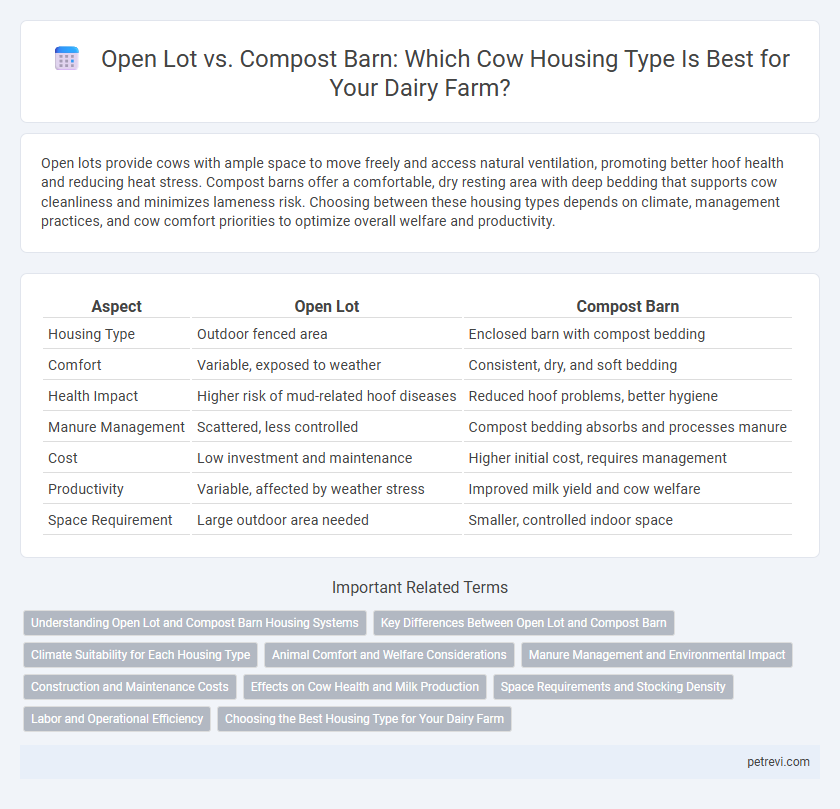Open lots provide cows with ample space to move freely and access natural ventilation, promoting better hoof health and reducing heat stress. Compost barns offer a comfortable, dry resting area with deep bedding that supports cow cleanliness and minimizes lameness risk. Choosing between these housing types depends on climate, management practices, and cow comfort priorities to optimize overall welfare and productivity.
Table of Comparison
| Aspect | Open Lot | Compost Barn |
|---|---|---|
| Housing Type | Outdoor fenced area | Enclosed barn with compost bedding |
| Comfort | Variable, exposed to weather | Consistent, dry, and soft bedding |
| Health Impact | Higher risk of mud-related hoof diseases | Reduced hoof problems, better hygiene |
| Manure Management | Scattered, less controlled | Compost bedding absorbs and processes manure |
| Cost | Low investment and maintenance | Higher initial cost, requires management |
| Productivity | Variable, affected by weather stress | Improved milk yield and cow welfare |
| Space Requirement | Large outdoor area needed | Smaller, controlled indoor space |
Understanding Open Lot and Compost Barn Housing Systems
Open lot housing provides cows with ample outdoor space, promoting natural behaviors and better air quality, which reduces respiratory issues. Compost barns offer a comfortable, dry environment with a deep-bedded system that facilitates manure decomposition and improves cow hygiene. Both systems impact cow welfare and productivity differently, depending on climate, management practices, and farm goals.
Key Differences Between Open Lot and Compost Barn
Open lot cow housing provides outdoor space with soil or gravel flooring, promoting natural behaviors and better ventilation but may expose cows to extreme weather conditions. Compost barns offer indoor shelter with a deep bedding system made of organic materials that promotes cow comfort, superior manure management, and reduced pathogen presence through aerobic composting. Key differences include environmental exposure, bedding type, and manure handling efficiency, impacting cow welfare and farm hygiene.
Climate Suitability for Each Housing Type
Open lot housing for cows is best suited for temperate to hot climates where ventilation and natural airflow reduce heat stress and promote animal comfort. Compost barns perform well in cooler and humid climates by providing insulated shelter and maintaining dry bedding through microbial heat generation. Proper climate suitability enhances cow health, welfare, and productivity for each housing type.
Animal Comfort and Welfare Considerations
Open lots provide cows with ample space to move freely and natural ventilation, reducing heat stress and promoting behavioral expression, essential for animal comfort and welfare. Compost barns offer a softer, drier resting area with improved cleanliness and insulation, minimizing lameness and mastitis risks while ensuring higher cow comfort. Choosing between these housing types depends on climate, management practices, and the prioritization of animal health and welfare outcomes.
Manure Management and Environmental Impact
Open lot systems expose manure directly to the environment, increasing runoff risks and methane emissions, whereas compost barns enhance manure decomposition by maintaining aerobic conditions, significantly reducing odor and greenhouse gas output. Compost barns facilitate more efficient nutrient recycling, allowing farmers to manage manure as valuable fertilizer, which minimizes soil and water contamination compared to open lots. Effective manure management in compost barns supports sustainable dairy farming by lowering environmental impact and improving animal welfare through cleaner housing conditions.
Construction and Maintenance Costs
Open lot housing for cows typically involves lower initial construction costs due to minimal infrastructure requirements like fencing and shade structures. Compost barns require higher investment in materials such as specialized bedding and ventilation systems, leading to increased upfront expenses. Maintenance costs for open lots tend to be lower, focusing on land management, whereas compost barns demand regular bedding replacement and system upkeep, raising ongoing costs.
Effects on Cow Health and Milk Production
Open lot housing promotes natural cow behavior and reduces heat stress, which enhances overall cow health and can increase milk yield. Compost barns provide a cleaner, drier environment that minimizes mastitis incidence and improves hoof health, leading to higher milk quality and production consistency. Studies show cows in compost barns exhibit better comfort and lower stress levels compared to those in open lots, positively impacting lactation performance.
Space Requirements and Stocking Density
Open lot systems typically require more land per cow due to the need for outdoor space, with recommended stocking densities ranging from 1.5 to 2.5 cows per acre depending on pasture quality. Compost barns, being indoor facilities, allow for higher stocking densities, often accommodating 8 to 12 cows per 1,000 square feet while providing a controlled environment that supports animal comfort and manure management. Optimizing space and stocking density in both systems is crucial for cow health, productivity, and environmental sustainability.
Labor and Operational Efficiency
Open lot cow housing requires less labor for routine cleaning and maintenance due to natural drainage and minimal bedding management, enhancing operational efficiency in large-scale dairy farms. Compost barns, while demanding more frequent bedding turning and temperature monitoring, improve cow comfort and reduce environmental waste but increase labor input and operational complexity. Choosing between open lots and compost barns depends on balancing labor availability, desired operational efficiency, and animal welfare priorities.
Choosing the Best Housing Type for Your Dairy Farm
Open lot housing provides cows with natural ventilation and ample space, reducing heat stress and promoting natural behavior, which can enhance milk production and overall health. Compost barns offer a comfortable, dry environment with soft bedding made from organic materials, improving cow welfare and reducing issues related to mud and manure exposure. Selecting the best housing type depends on climate, land availability, and management capacity, ensuring optimal cow comfort, hygiene, and productivity for your dairy farm.
Open lot vs Compost barn for Cow housing type Infographic

 petrevi.com
petrevi.com